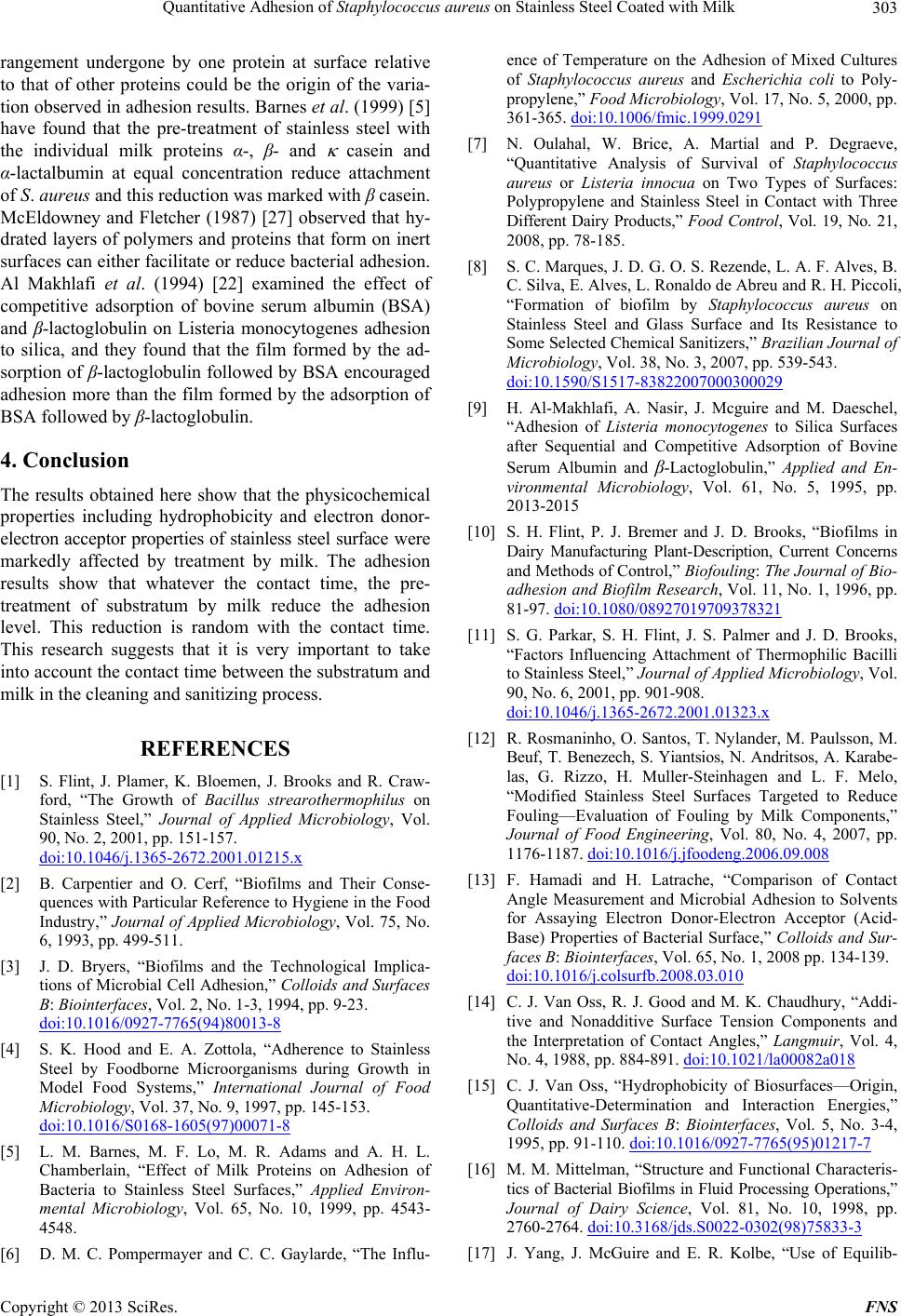
Quantitative Adhesion of Staphylococcus aureus on Stainless Steel Coated with Milk 303
rangement undergone by one protein at surface relative
to that of other proteins could be the origin of the varia-
tion observed in adhesion results. Barnes et al. (1999) [5]
have found that the pre-treatment of stainless steel with
the individual milk proteins α-, β- and
casein and
α-lactalbumin at equal concentration reduce attachment
of S. aureus and this reduction was marked with β casein.
McEldowney and Fletcher (1987) [27] observed that hy-
drated layers of polymers and proteins that form on inert
surfaces can either facilitate or reduce bacterial adhesion.
Al Makhlafi et al. (1994) [22] examined the effect of
competitive adsorption of bovine serum albumin (BSA)
and β-lactoglobulin on Listeria monocytogenes adhesion
to silica, and they found that the film formed by the ad-
sorption of β-lactoglobulin followed by BSA encouraged
adhesion more than the film formed by the adsorption of
BSA followed by β-lactoglobulin.
4. Conclusion
The results obtained here show that the physicochemical
properties including hydrophobicity and electron donor-
electron acceptor properties of stainless steel surface were
markedly affected by treatment by milk. The adhesion
results show that whatever the contact time, the pre-
treatment of substratum by milk reduce the adhesion
level. This reduction is random with the contact time.
This research suggests that it is very important to take
into account the contact time between the substratum and
milk in the cleaning and sanitizing process.
REFERENCES
[1] S. Flint, J. Plamer, K. Bloemen, J. Brooks and R. Craw-
ford, “The Growth of Bacillus strearothermophilus on
Stainless Steel,” Journal of Applied Microbiology, Vol.
90, No. 2, 2001, pp. 151-157.
doi:10.1046/j.1365-2672.2001.01215.x
[2] B. Carpentier and O. Cerf, “Biofilms and Their Conse-
quences with Particular Reference to Hygiene in the Food
Industry,” Journal of Applied Microbiology, Vol. 75, No.
6, 1993, pp. 499-511.
[3] J. D. Bryers, “Biofilms and the Technological Implica-
tions of Microbial Cell Adhesion,” Colloids and Surfaces
B: Biointerfaces, Vol. 2, No. 1-3, 1994, pp. 9-23.
doi:10.1016/0927-7765(94)80013-8
[4] S. K. Hood and E. A. Zottola, “Adherence to Stainless
Steel by Foodborne Microorganisms during Growth in
Model Food Systems,” International Journal of Food
Microbiology, Vol. 37, No. 9, 1997, pp. 145-153.
doi:10.1016/S0168-1605(97)00071-8
[5] L. M. Barnes, M. F. Lo, M. R. Adams and A. H. L.
Chamberlain, “Effect of Milk Proteins on Adhesion of
Bacteria to Stainless Steel Surfaces,” Applied Environ-
mental Microbiology, Vol. 65, No. 10, 1999, pp. 4543-
4548.
[6] D. M. C. Pompermayer and C. C. Gaylarde, “The Influ-
ence of Temperature on the Adhesion of Mixed Cultures
of Staphylococcus aureus and Escherichia coli to Poly-
propylene,” Food Microbiology, Vol. 17, No. 5, 2000, pp.
361-365. doi:10.1006/fmic.1999.0291
[7] N. Oulahal, W. Brice, A. Martial and P. Degraeve,
“Quantitative Analysis of Survival of Staphylococcus
aureus or Listeria innocua on Two Types of Surfaces:
Polypropylene and Stainless Steel in Contact with Three
Different Dairy Products,” Food Control, Vol. 19, No. 21,
2008, pp. 78-185.
[8] S. C. Marques, J. D. G. O. S. Rezende, L. A. F. Alves, B.
C. Silva, E. Alves, L. Ronaldo de Abreu and R. H. Piccoli,
“Formation of biofilm by Staphylococcus aureus on
Stainless Steel and Glass Surface and Its Resistance to
Some Selected Chemical Sanitizers,” Brazilian Journal of
Microbiology, Vol. 38, No. 3, 2007, pp. 539-543.
doi:10.1590/S1517-83822007000300029
[9] H. Al-Makhlafi, A. Nasir, J. Mcguire and M. Daeschel,
“Adhesion of Listeria monocytogenes to Silica Surfaces
after Sequential and Competitive Adsorption of Bovine
Serum Albumin and β-Lactoglobulin,” Applied and En-
vironmental Microbiology, Vol. 61, No. 5, 1995, pp.
2013-2015
[10] S. H. Flint, P. J. Bremer and J. D. Brooks, “Biofilms in
Dairy Manufacturing Plant-Description, Current Concerns
and Methods of Control,” Biofouling: The Journal of Bio-
adhesion and Biofilm Research, Vol. 11, No. 1, 1996, pp.
81-97. doi:10.1080/08927019709378321
[11] S. G. Parkar, S. H. Flint, J. S. Palmer and J. D. Brooks,
“Factors Influencing Attachment of Thermophilic Bacilli
to Stainless Steel,” Journal of Applied Microbiology, Vol.
90, No. 6, 2001, pp. 901-908.
doi:10.1046/j.1365-2672.2001.01323.x
[12] R. Rosmaninho, O. Santos, T. Nylander, M. Paulsson, M.
Beuf, T. Benezech, S. Yiantsios, N. Andritsos, A. Karabe-
las, G. Rizzo, H. Muller-Steinhagen and L. F. Melo,
“Modified Stainless Steel Surfaces Targeted to Reduce
Fouling—Evaluation of Fouling by Milk Components,”
Journal of Food Engineering, Vol. 80, No. 4, 2007, pp.
1176-1187. doi:10.1016/j.jfoodeng.2006.09.008
[13] F. Hamadi and H. Latrache, “Comparison of Contact
Angle Measurement and Microbial Adhesion to Solvents
for Assaying Electron Donor-Electron Acceptor (Acid-
Base) Properties of Bacterial Surface,” Colloids and Sur-
faces B: Biointerfaces, Vol. 65, No. 1, 2008 pp. 134-139.
doi:10.1016/j.colsurfb.2008.03.010
[14] C. J. Van Oss, R. J. Good and M. K. Chaudhury, “Addi-
tive and Nonadditive Surface Tension Components and
the Interpretation of Contact Angles,” Langmuir, Vol. 4,
No. 4, 1988, pp. 884-891. doi:10.1021/la00082a018
[15] C. J. Van Oss, “Hydrophobicity of Biosurfaces—Origin,
Quantitative-Determination and Interaction Energies,”
Colloids and Surfaces B: Biointerfaces, Vol. 5, No. 3-4,
1995, pp. 91-110. doi:10.1016/0927-7765(95)01217-7
[16] M. M. Mittelman, “Structure and Functional Characteris-
tics of Bacterial Biofilms in Fluid Processing Operations,”
Journal of Dairy Science, Vol. 81, No. 10, 1998, pp.
2760-2764. doi:10.3168/jds.S0022-0302(98)75833-3
[17] J. Yang, J. McGuire and E. R. Kolbe, “Use of Equilib-
Copyright © 2013 SciRes. FNS